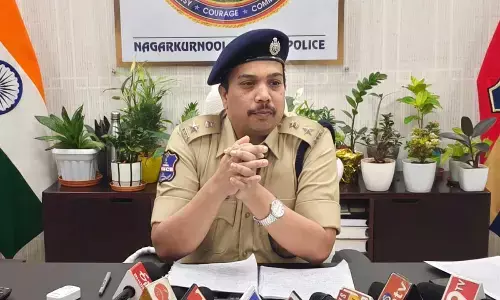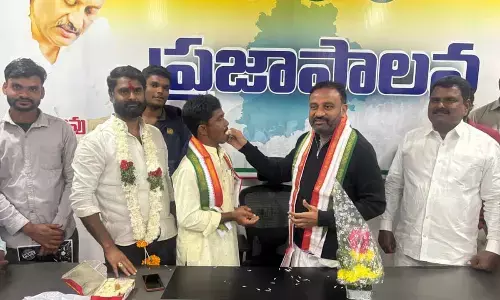When the divine daughter arrives

When The Divine Daughter Arrives. Yellow and red are the hues of the season in the auspicious month of Ashadam in the Telangana region where a colourful display of customs and traditions usher in a carnival like atmosphere replete with music, dancing, processions and masquerade.
Yellow and red are the hues of the season in the auspicious month of Ashadam in the Telangana region where a colourful display of customs and traditions usher in a carnival like atmosphere replete with music, dancing, processions and masquerade.
.jpg)
The images of women wearing bright yellow coloured sarees with red borders, the colours of turmeric and vermilion which incidentally adorn the shining brass or earthen pots made more pleasing to the eyes through neem leaves tied around them and the flickering lamps atop, have been captured for posterity through the camera lens, celebrated on celluloid and replicated on canvas ultimately getting it the well deserved status of a “State festival”. The festival has over the years emerged as an acknowledgement of the “Telangana ethos” with women politicians cutting across party lines queuing up before the mother goddess much like the Iftar parties attended by their male counterparts. If we had hoardings with a Sonia Gandhi depicted with the all pervasive “Bonam” when the Telangana state was formed, it is due to the popular appeal that the festival has and the ultimate identification that it denotes.
The festival with a long history dating back to 1813 started as a thanksgiving to the goddess who is said to have rid the twin cities of Hyderabad and Secunderabad of a deadly plague that had claimed thousands of lives. A military battalion from Hyderabad deployed at Ujjain is said to have prayed to the goddess “Mahakali” there and installed her idol at Secunderabad after their prayers had been answered. Another version based on mythology states that this is the time when the goddess comes to her maternal home and is pampered with food, clothing and celebrations reserved for a daughter visiting her parents. The worship of Shakti and her forms like Maisamma, Pochamma, Yellamma, Nookaalamma, Maremma and several other local deities and “Grama devatas” (village goddesses) became an annual event beginning with the first Sunday of Ashadam and continued over the next four weeks with celebrations spread across different areas in the capital. The name “Bonalu” was derived from the word “Bhojanam “(food) which in this case is rice cooked with milk and jaggery filled in the brass pots and taken to the temple with great devotion and care. The women also offer “Thottelu” (a colourful paper structure supported by sticks) as a mark of respect along with sarees and bangles that are given to “Sumangalis” (Married women)
Although it is not clear how all other elements came to be added, rituals including women in a trance balancing brass pots over their heads and dancing to the rhythmic beats of drums, “Pothuraju” or the brother of the goddess who is usually a well built man with a whip lashing himself with it, the pain made bearable by the spirits he consumes for this ordeal and the “Rangam”( oracle’s predictions) where a woman who invokes the goddess forecasts the prospects for the year and even answers questions posed by devotees have become an important part of the festival making it an event like no other. The “Ghatam” a copper pot decorated as the goddess also came to be carried by the local priest with the festival concluding with the immersion of the idol to the beating of drums on the last day. However traditional festivities have had their share of changes with time.
Veeresh Babu an employee with the postal department and a photographer smitten by “Bonalu” and the “Medaram” festival, which he has captured on his lens for more than two and a half decades, has thousands of photographs covering various aspects of Bonalu. “Earlier the Pothuraju would have his body smeared with turmeric but today’s models have yellow paint smeared on their bodies. There were places like Nayapul which had men dressed in sarees get into a trance and predict the future in the past. Another feature fast disappearing is the humble earthen pot used for “Bonalu” replaced by the more showy brass ones,” he points out. Although he has held a solo exhibition in the ICCR art gallery in 2012 on the “Bonalu” theme and has held shows in cities like Mumbai and Delhi, he says he is clueless about how to showcase his works in the newly formed state of Telangana where there are many voices speaking for its culture and traditions. “I have about 50 rare photographs from my collection, which I will probably arrange one Sunday near the General Post Office where I work,” he says unwittingly making a statement on the sad fact of lack of connections hampering recognition to genuine documentation.
Scintillating folk tunes in praise of the goddess are a great hit not only at the “Bonalu” but at any celebration involving fun and merriment. It is not surprising to find young and old alike dancing to the tune of “Mayadari Maisammao” or “Kodibaye Lachammadi”, which remain evergreen hits despite the addition of many new songs to the chartbuster list. Bonalu has now become a multi media offering with art, music, poetry and prose collaborating to bring out its true meaning and fervour. “We have found a way of rediscovering Telangana through the motif of Bonalu, which has over the years shed its past image as a natural appeasement to the goddess Kali who had helped in ridding the city of plague and evolved into a event celebrating the cultural diversity of Telangana,’ says city based sculptor Manohar Chiluveru who has the experience of creating several works on the subject known for their artistic content.
Dulam Satyanarayana, a documentary film maker chronicles this change in a compelling manner. The emergence of “Bonalu” as a celebration of composite culture in a pluralistic society makes it a true carnival with people from different cross sections of society participating in it,” he says. Scenes like a young woman applying vermilion to the goddess with one hand and speaking over the mobile phone with another and that of a cop controlling the crowd as part of his duty only to return as a devotee are compelling vignettes of tradition and modernity as well as duty and devotion. “The Monsoon Oracle” is an earlier documentary made by Shrenik Rao, which traces the lives of ordinary characters who become part of the festivities as women who invoke the goddess making future predictions.
Feature films have used the Bonalu backdrop to cover an array of emotions from turmoil to triumph in interesting ways over the years. This lively festival that is marked by a riot of colour symbolised by the Bonalu and the women carrying them, the beating of drums alternating with whiplashes of the Pothuraju, the folk tunes reverberating through the streets and crowds of people waiting for a glimpse of the goddess is unrivalled in scale and variety and is truly a celebration of life through the mystique of the goddess.
Aruna Ravikumar


















